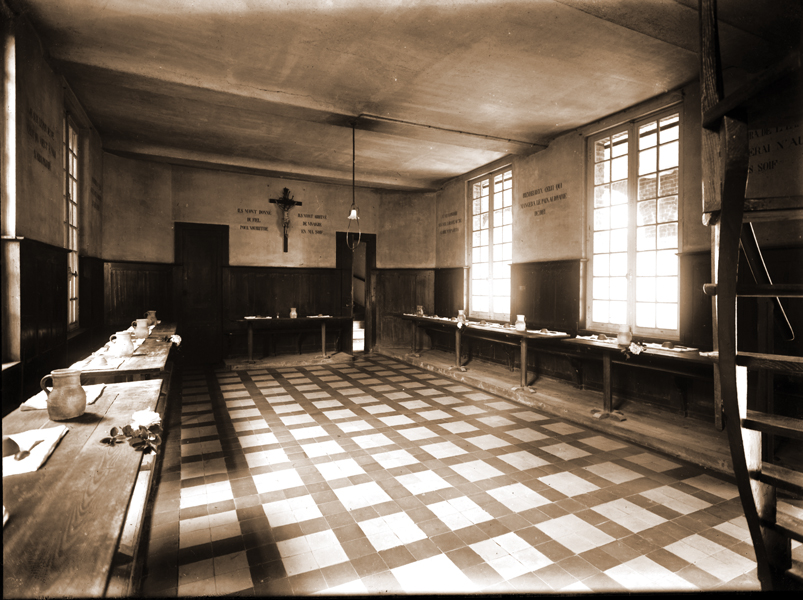Monks and nuns take their meals in silence in the refectory. This is a long-established monastic tradition in all Great Orders. During the meal, a member of the community reads. In Lisieux, a book was read continuously, interspersed with the reading, at the evening meal, of the French translation of the Office (Dom Gréa), and with the reading of circulars received from other Carmels. These circulars are short biographies of deceased sisters. This quiet reading had a powerful impact on the listeners; this can be verified in numerous passages from Thérèse's works, directly inspired by this reading, notably in the circulars.
The Carmelite whose turn it is goes up to the pulpit in the refectory, and she does not read as in a conversation! The reading is done in a quasi-musical way by double-tono (from Latin: in a straight, united tone). That is to say that the text is read on the same note, an E for example. To improve the hearing of the text, the note is lowered by a semitone at the end of a sentence.
Books read at lunch
At 11 a.m. (10 a.m. in summer; 11:30 a.m. during Lent and fast days)
Some of the works read are not in the archives of the monastery; they were no doubt then loaned to the Community.
Two numbers of Constitutions and every Friday, the primitive rule in full.
These rather brief readings were followed by a biography continuously :
- In 1893, we read, from Abbé Bougaud: Affair Saint Joan of Chantal and Origins of the Visitation, Paris, 1865, 2 volumes. Thérèse mentions it in to Latvia.
- Céline remembers that when she entered in September 1894, it read: Mr. Faillon: The life of Mr Olier, Paris, 4th ed., 1873, in 3 volumes.
- We then read a biography of Columbus, not preserved but perhaps that of the Baron de Bonnefoux: Life of Christopher Columbus. Paris: Arthus Bertrand, [1853]. "Just as the genius of Christopher Columbus, writes Thérèse, made him sense that there was a new world, when no one had thought of it, so I felt that another land would one day serve me as a stable abode." Ms A, 6 v°.
- In 1897, a Affair Saint Louis de Gonzague, by Daurignac, Le Puy, 1864. We remember that it was after hearing a passage from this book that Thérèse said to her godmother: "Me too, after my death, I will make it rain roses".
- Michel-Ange Marino, of the Order of Minims, Lives of Fathers of the Eastern Deserts, with their spiritual doctrine and monastic discipline, Lyon, 1824. Thérèse alludes to a passage from this work when she asks Mother Agnès, on July 11, 1897, to add at the end of her last manuscript "the story of the converted sinner who died of love ".
- PR Ribadeneira: The Lives of the Saints and Feasts of the whole year, revised and expanded French translation of new feasts, lives of new saints and blesseds, by Father E. Daras, Paris, 3rd ed., 1862, 12 volumes.
- Lives of the Saints according to Les Bollandistes, Surius, Ribadeneira, Father Giry, Les Hagiologies, by M. L'Abbé Paul Guérin, 1868.
On Sundays and certain feast days, the reading of the biography was replaced by that of The liturgical year by Dom P. Guéranger. It was Mother Agnès who reported this work to Mother Marie de Gonzague.
During Lent, we read a Life of Our Lord ; during one of Thérèse's last three Lents, we read: The Sorrowful Passion of Our Lord Jesus Christ, based on the meditations of Anne-Catherine Emmerich, Augustinian nun of the convent of Dulmen. Paris, 1866.
When a Circular (obituary of a deceased Carmelite) was received, it was read instead of the current biography. These circulars were then kept at the community library. Thérèse said to Mother Agnès on May 27, 1897: “I would like to have a circular. I don't really understand why there are sisters who ask not to have one; it's so sweet to know each other, to know a little with whom we will live forever."
See the circulars read in the refectory between 1888 and 1897
At the evening meal
At 18 hours
- The translation of the Martyrology which in the morning had been read in Latin at the Office of Prime.
- The translation of the Lessons of Matins, and, on certain feasts, of the entire Office, with the exception of the Psalms.
Towards the end of Thérèse's religious life, the following were used for this purpose: The Roman Breviary, made available to communities and pious people through an annotated translation, and preceded by an introduction by Father Dom A. Gréa, Lons- le-Saunier, 2 t., 1893 and 1894.
- The passage of The liturgical year by Dom Guéranger devoted to the feast of the following day.
- Finally, if there was time, we continued the biography of the saint being read.
- Every year, on the evening of October 4, the anniversary of the death of Saint Teresa of Avila, the story of her last days was read in François de Ribera: Life of Saint Therese, translation by M. Bouix, SJ, Paris and Lyons, 1868. This account is found in book III, ch. xv, p. 315-320. In the same work, we read, on Palm Sunday, at the 11 o'clock meal, the account of the grace which the Saint received in receiving communion that day. A passage from this chapter was able to reinforce in Thérèse's heart the desire for daily communion. (book IV, ch. xii, Of his great devotion to the most holy Sacrament of the altar, p. 470.)
Notes by Sr Marie-Emmanuel (1886-1961), Carmelite archivist in Lisieux





